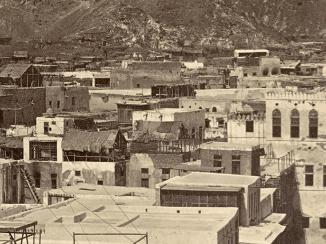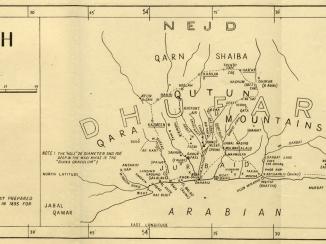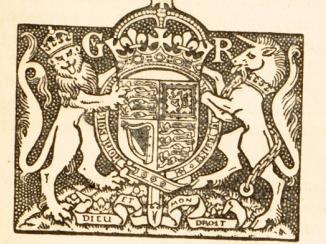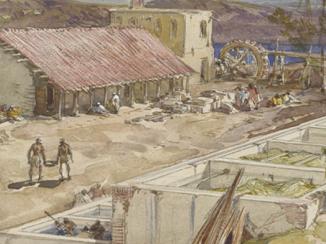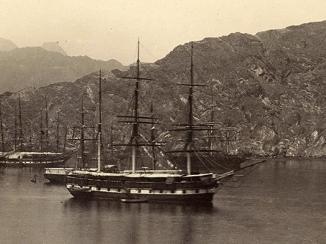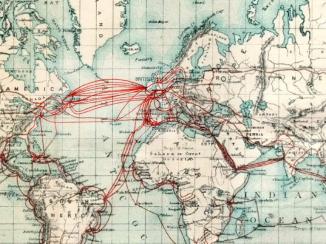Survey of the East Coast of Africa by Captain Thomas Smee and Lieutenant Henry Hardy in the East India Company's Cruiser Ternate
IOR/L/MAR/C/586
444 items in this record
Search within this record
The record is made up of 1 volume (211 folios). It was created in 1810-1811. It was written in English. The original is part of the British Library: India Office The department of the British Government to which the Government of India reported between 1858 and 1947. The successor to the Court of Directors. Records and Private Papers Documents collected in a private capacity. .
About this record
- Content
A survey of the East Coast of Africa by Captain Thomas Smee and Lieutenant Henry Hardy in the East India Company cruisers the Ternate and the Sylph (1810-1811).
Folios 23-142 contain a report of proceedings on board the Ternate , 1 January-25 September 1811. The report contains:
- The daily entries for the voyage from Bombay [Mumbai] to Duraja [Darsah] (15 January 1811), Abdel Curia [Abd al-Kuri] (16 January 1811), Cape Guardafui (18 January 1811), Cape Bassas (29 January 1811), Magadosha [Mogadishu] (2 February 1811), Brava [Baraawe] (3 February 1811), Juba [Jubba] (4 February 1811), Island of Keewyaoo [Kiwayu] (6 February 1811), Island of Patté [Paté] (7 February 1811), Formosa Bay [Ungwana Bay] (15 February 1811), Mombass [Mombasa] (18 February 1811), Island of Pemba (21 February 1811) and Zanzibar (23 February 1811)
- The daily entries for the voyage from Zanzibar to Tumbat Island [Tumbatu Island] (10 April 1811), Kewyoo Island [Kiwayu Island] (11 April 1811), Cape d'Orfici (21 April 1811), Cape Felix (22 April 1811), Bird Island (24 April 1811), Babelmandel [Bab-el-Mandeb] (26 April 1811) and Mocha (27 April 1811)
- The daily entries for the voyage from Mocha to Cape Israel (17 May 1811), Gedam Island (19 May 1811) and Judda [Jeddah] (27 May 1811)
- The daily entries for the voyage from Judda to Sabaya Islands [Jabal al-Sabaya] (8 August 1811), Mocha (10 August 1811), Babelmandel (29 August 1811), Mette Island (1 September 1811), Bird Island (6 September 1811) and arrival at Surat (23 September 1811) (ff 23-142).
Smee describes the Island of Patté as being in a 'very troubled state' owing to the rival claims of two cousins to the 'Sooltanship', with the younger claimant 'Sooltan Ahmed [Sultan Ahmad bin Shaykh al-Nabhani]' having the support of the stronger faction, and keeping his elder cousin confined to a 'small mud fort near the Town'. Smee provides a detailed report of his reception, negotiations, and eventual escape from Paté (ff 55-67). He also provides detailed accounts of his meetings with the 'Hakeem' [Hakim] of Zanzibar, 'Yacood' [i.e. Yaqut bin Ambar al-Habashi], whom Smee describes as being a 'Eunuch Slave of the Imaum of Muscat [i.e. Sulṭān Sa‘īd II bin Sulṭān Āl Bū Sa‘īd] born in Amhara, a Province of Abyssinia' (ff 81-92), which is followed by a 'Description of the Island of Zanzibar or Zingebaur as it is called by the Natives' (ff 99-110). The latter includes a description of the slave market together with moral arguments against slavery (ff 103-105). Smee was later received by the Dola [Dawla] of Mocha, who informed him that the 'Imaum' of Senna [i.e. Imam of San‘a’, Al-Mutawakkil ala ‘Allah Ahmad bin ‘Ali al-Qāsimī One of the ruling families of the United Arab Emirates; also used to refer to a confederation of seafaring Arabs led by the Qāsimī tribe from Ras al Khaima. ], had taken the field against Wahabee [the Wahhabi], and marched towards the rebel states of Hodeida [Hudayda] Lopeia [Luhayya] and Bettefackie [Bayt al-Faqih], and he wished the cruiser to remain for the protection of Mocha Roads. Smee had to decline the Dawla's request, however, as it would impede his delivery of dispatches to the Viceroy of Egypt [Kavalali Muhammad ‘Ali Pasha An Ottoman title used after the names of certain provincial governors, high-ranking officials and military commanders. ] and his planned voyage to Jeddah (ff 122-23 and f 160). He continued his voyage and subsequently met the Sharif of Mecca [Ghālib bin Musā’id al-Hāshimī], and 'Arabee Jellanee' [‘Arabi Jilani], the principal merchant at Jeddah, to whom he entrusted the Governor's letters for the Viceroy of Egypt and the 'Commanding Officer of the Turkish Forces' [i.e. Tusun Pasha An Ottoman title used after the names of certain provincial governors, high-ranking officials and military commanders. ] (ff 127-28).
Folios 163-211 contain a report by Lieutenant Hardy, including:
- A description of the coast of Africa from Cape Guardafui to Magadixa [Mogadishu], Marca [Merca], Brava and Zanzibar, and the return voyage of the Company's Brig Sylph to Chaul (12 October 1811)
- An extract from the log refuting James Bruce's hypothesis about the monsoon on the east coast of Africa
- An account of different rivers on the coast from Zualiffe towards Mozambique (ff 188-99)
- The Glossaries of Swahili and "Galla" [Oromo] vocabularies compiled by Lieutenant Hardy (ff 199-206)
- The minutes of the Government-in-Council on the actions taken, and the information collected by Captain Smee and Lieutenant Hardy during the survey, including an application from Smee for financial compensation (ff 207-11).
Hardy describes the arrival of the brother-in-law of the 'King of Johanna' [Sultan Alawi bin Husayn Mwinye Fani] at Zanzibar in 'great distress for Provisions and Clothes'. The party had earlier departed from Johanna [Anjouan] with 'some Portuguese Prisoners' for Mozambique, and included 'five Gentlemen [,] one Captain and 12 Sailors, besides thirty two Slaves most of them femini [sic] ones, which they said were a present from the Governor of Mozambique [António Manuel de Melo e Castro de Mendonça] to the King of Johanna'. Hardy was later approached by the Vizier of the deposed Sultan of Paté to help 'enable him to repair his boat, she having run on shore in bad weather whilst attempting to get to Mombass to secure his property' (ff 166-67).
The volume also includes:
- A letter from Captain Thomas Smee, Commander of the Ternate , to W J Hamilton, Secretary to the Government and the Marine Department, 23 December 1810, requesting that the Sylph accompany the Ternate in exploring the coast of Africa, and for the latter to be allowed to transport 1000 Rupees Indian silver coin also widely used in the Persian Gulf. ' worth of presents for the 'natives necessity' (ff 3-4)
- A letter from Deputy Secretary James Farish to Captain Smee, 31 December 1810, containing sailing instructions for the exploration of the African coast from 'Cape Gardafui to the Southward, as far as may be found compatible with the season of the year', with particular attention to the Somali Coast from Cape Gardafui [Guardafui] to Brava [Baraawe], and proceeding to the Island of Paté, 'a civilized and mercantile resort' to meet the Prince [i.e. Sultan]. Farish requested Smee to 'endeavor to learn which of the Rivers, that reach the sea on that [East African] coast may be with most probability conjectured to give passage to the waters of the Niger'. He further instructed Smee to continue sailing southwards from Paté 'as far as the Island of Zanzibar, in which, as belonging to our ally the Imaum of Muscat, you may rely on a friendly reception'. Smee was directed to collect as much information as possible about the southern branch of the Nile, the Muslim Principality of Hurhur [Harar], the Christian states of Yafat/Ifat and Shoa, and the 'great in-land Cities (under Mussulman Princes) of Tombuctoo [Timbuktu], Hoolsaye [Hawsa] and Cashna [Katsina]' (ff 4-13)
- An extract of a letter from Captain David Seton, 21 September 1801, on his failure to obtain any information about Housay [Hawsa] and Tumbuctoo and providing certain details about Burrava [Baraawe], the southern branch of the Nile [i.e. the White Nile], Melinda [Malindi] and the trade in slaves, silk and cotton on the east coast of Africa (ff 13-14)
- An extract from a memoir by Ibrahim Pirkar, 21 September 1800, about the port of Burbureea [Berbera] and its trade with the ports located along the Gulph of Kutch, Muskat [Muscat], Mocha, Mukulla [Mukalla] and Judda [Jeddah], the dearth of information about Tumbuctoo and Kassinan [Katsina Emirate], and the death of an Englishman reported by the merchant Hajee Mohummud [Haji Muhammad al-Habashi] of Abyssinia [Ethiopia] (ff 14-15)
- The translation of a report from Ibrahim Purkar to Governor of Bombay Jonathan Duncan, 26 February 1809 about Burbureea, Mocha, Yuf’at [Ifat], Gondur [Gondar], Goojam [Gojjam], Begamdur [Begemder], Lasna [Lasta] and Madramra (ff 15-17)
- A description of the rivers of Jenne [Djenné] called Zambexe [Zambezi], from the Island of Mozambique to Quilimane [Quelimane], Luabo, Tete, Lupatia [Lupata], Kingdom of Tanbard, Massangane, Tipui, Chicooa [Chicora], Zumbo and Manica (ff 17-21)
- A list of different tribes composing the cargo of slaves taken by the East India Company ship Sir Edward Hughes . The list includes the names of seventeen different tribes (ff 21-22)
- A receipt from the Sultan of Paté, Ahmad bin Shaykh al-Nabhani, listing the articles received from the Ternate and dated at Paté Harbour, 10 February 1811, with an additional note from Captain Smee, complaining that they had been 'extorted' from him by the Sultan (ff 142-43)
- A letter from Lieutenant Hardy to Captain Smee, dated 25 February 1811, informing him of the 'many bad and dangerous qualities' of the Sylph as a Schooner, and suggesting that it be 'rigged as a Brig' (ff. 143-48)
- A committee held by Captain Smee, Lieutenant Hardy, Lieutenant James Arthur, and Assistant Surgeon George Wigham at Zanzibar Harbour on 1 April 1811 to consider the contents of a letter received from the 'Nacqudahs' [i.e. Nakhudas or Captains] of 'three vessels belonging to the Port of Surat, and one to Bownagur [Bhavnagar] setting forth the ill treatment they are subject to from the Hakeem of Zanzibar and ‘soliciting on the part of their several owners, the services of the Hon:ble Company's Brig Sylph that she may 'remain with them and afford a security to them’ (ff 148-51)
- 'A Comprehensive List of Dialects, in use on the Coast of East Africa', compiled by Captain Smee on the basis of information provided by the merchants Mahomed Abdelriuman Ben Omar Seomary [Muhammad Abd al-Rahman bin Omar al-Sumari] (Somali and 'Galla' [Oromo]); Syed Moother Ben Syed Aboo Booker of Baraawe [Sayyid Mudhar bin Sayyid Abu Bakr al-Barawi] (Somali and 'Galla' [Oromo]); and Mahomed Ben Caliph of Zanzibar [Muhammad bin Khalifa al-Zinjibari] (Swahili) (ff 151-56, and f 87 and f 89)
- The exchanges of letters between Captain Smee and the British Agent in the Gulf of Arabia, Captain Henry Rudland, to: arrange for the treatment of sick crew members on board the Ternate ; convince the 'Commandant' of Hudaydah, Hadjee Jewah Hussan [Haji Jawa Hasan] to release the ship Rahmanee [Rahmani] commanded by Nacooda Hadjee Hamood of Tellicherry [Nakhuda Haji Hammud Thalasiri]; convey a letter from the Governor of Bombay to the Viceroy of Egypt tactfully refusing the latter's request to furnish two warships for the war being waged against the Wahaby [Wahhabi]; and assess the suitability of the dhows Salamed Passand [Salamat Pasand] and Hamdee [Hamdi] for the transportation of 1000 bales of coffee from Mocha to Bombay on behalf of the East India Company (ff 156-62).
- Extent and format
- 1 volume (211 folios)
- Arrangement
The entries are recorded in chronological order from the front to the rear of the volume.
- Physical characteristics
The foliation sequence (used for referencing) commences at the first folio with 1 and terminates at the last folio with 211; these numbers are written in pencil, are circled, and are located in the top right corner of the recto The front of a sheet of paper or leaf, often abbreviated to 'r'. side of each folio. An additional foliation sequence is present in parallel between ff 2-211; these numbers are also written in pencil, but are not circled. The foliation sequence does not include the front and back covers, nor does it include the leading and ending flyleaves.
- Written in
- English in Latin script
- Type
- Archival file
Archive information for this record
- Original held at
- British Library: India Office The department of the British Government to which the Government of India reported between 1858 and 1947. The successor to the Court of Directors. Records and Private Papers Documents collected in a private capacity.
- Access conditions
Unrestricted
- Archive reference
- IOR/L/MAR/C/586
- Date(s)
- 1810-1811 (CE, Gregorian)
Access & Reference
History of this record
Related search terms
- Subjects
- Cloth tradeCoffee tradeSomali peopleMerchantsSwahili peopleGujarati merchantsArab merchantsArmed forcesMerchant shippingSlave tradeTrade (practice)Customs dutySurveys
- Places
- JuddaIsland of PattéBravaMochaTumbuctooCape GuardafuiShoaMagadoshaIsland of LamooLufee RiverCutchZanzibarMuscatBombayBabelmandel
- People & organisations
- Sultan of PatéSultan of NdzuwaniPolitical AgentHakim of ZanzibarTernate, sloop-of-warSylph, schoonerĀl Bū Sa'īd dynasty, Imam of Muscat and OmanGrand Sharif of MeccaPresident and Governor of Bombay in CouncilMuhammad Abd al-Rahman bin Omar al-SumariMudhar bin Sayyid Abu Bakr al-BarawiMua'llim 'Ali Sahib HindiMuhammad bin Khalifa al-Zinjibari'Arabi Jilani
Use and share this record
- Share this record
- Cite this record in your research
Survey of the East Coast of Africa by Captain Thomas Smee and Lieutenant Henry Hardy in the East India Company's Cruiser Ternate , British Library: India Office Records and Private Papers, IOR/L/MAR/C/586, in Qatar Digital Library <https://www.qdl.qa/archive/81055/vdc_100022551646.0x00025d> [accessed 18 May 2024]
- Link to this record
https://www.qdl.qa/en/archive/81055/vdc_100022551646.0x00025d
- IIIF details
This record has a IIIF manifest available as follows. If you have a compatible viewer you can drag the icon to load it.https://www.qdl.qa/en/iiif/81055/vdc_100022551646.0x00025d/manifestOpen in Universal viewerOpen in Mirador viewerMore options for embedding images
Copyright: How to use this content
- Reference
- IOR/L/MAR/C/586
- Title
- Survey of the East Coast of Africa by Captain Thomas Smee and Lieutenant Henry Hardy in the East India Company's Cruiser Ternate
- Pages
- front, back, spine, edge, head, tail , front-i, i-r:iii-v, 1r:211v, iv-r:vii-v, back-i
- Author
- East India Company, the Board of Control, the India Office, or other British Government Department
- Usage terms
- Open Government Licence




























































































































































































































































































































































































































































